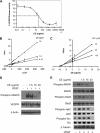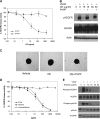Novel angiogenesis inhibitory activity in cinnamon extract blocks VEGFR2 kinase and downstream signaling
- PMID: 19969552
- PMCID: PMC3105590
- DOI: 10.1093/carcin/bgp292
Novel angiogenesis inhibitory activity in cinnamon extract blocks VEGFR2 kinase and downstream signaling
Abstract
As a critical factor in the induction of angiogenesis, vascular endothelial growth factor (VEGF) has become an attractive target for anti-angiogenesis treatment. However, the side effects associated with most anti-VEGF agents limit their chronic use. Identification of naturally occurring VEGF inhibitors derived from diet is a potential alternative approach, with the advantage of known safety. To isolate natural inhibitors of VEGF, we established an in vitro tyrosine kinase assay to screen for diet-based agents that suppress VEGFR2 kinase activity. We found that a water-based extract from cinnamon (cinnamon extract, CE), one of the oldest and most popular spices, was a potent inhibitor of VEGFR2 kinase activity, directly inhibiting kinase activity of purified VEGFR2 as well as mitogen-activated protein kinase- and Stat3-mediated signaling pathway in endothelial cells. As a result, CE inhibited VEGF-induced endothelial cell proliferation, migration and tube formation in vitro, sprout formation from aortic ring ex vivo and tumor-induced blood vessel formation in vivo. Depletion of polyphenol from CE with polyvinylpyrrolidone abolished its anti-angiogenesis activity. While cinnamaldehyde, a component responsible for CE aroma, had little effect on VEGFR2 kinase activity, high-performance liquid chromatography-purified components of CE, procyanidin type A trimer (molecular weight, 864) and a tetramer (molecular weight, 1152) were found to inhibit kinase activity of purified VEGFR2 and VEGFR2 signaling, implicating procyanidin oligomers as active components in CE that inhibit angiogenesis. Our data revealed a novel activity in cinnamon and identified a natural VEGF inhibitor that could potentially be useful in cancer prevention and/or treatment.
Figures






Similar articles
-
Grape seed extract inhibits angiogenesis via suppression of the vascular endothelial growth factor receptor signaling pathway.Cancer Prev Res (Phila). 2008 Dec;1(7):554-61. doi: 10.1158/1940-6207.CAPR-08-0040. Cancer Prev Res (Phila). 2008. PMID: 19139005 Free PMC article.
-
Procyanidin-B2 enriched fraction of cinnamon acts as a proteasome inhibitor and anti-proliferative agent in human prostate cancer cells.IUBMB Life. 2018 May;70(5):445-457. doi: 10.1002/iub.1735. Epub 2018 Mar 14. IUBMB Life. 2018. PMID: 29537730
-
Cultivated Orostachys japonicus extract inhibits VEGF-induced angiogenesis via regulation of VEGFR2 signaling pathway in vitro and in vivo.J Ethnopharmacol. 2020 Jun 28;256:112664. doi: 10.1016/j.jep.2020.112664. Epub 2020 Feb 8. J Ethnopharmacol. 2020. PMID: 32045685
-
Water extract of Cinnamomum cassia suppresses angiogenesis through inhibition of VEGF receptor 2 phosphorylation.Biosci Biotechnol Biochem. 2015;79(4):617-24. doi: 10.1080/09168451.2014.993917. Epub 2015 Jan 3. Biosci Biotechnol Biochem. 2015. PMID: 25560253
-
Advances in the molecular signaling mechanisms of VEGF/VEGFR2 in fundus neovascularization disease (Review).Exp Ther Med. 2025 May 20;30(1):143. doi: 10.3892/etm.2025.12893. eCollection 2025 Jul. Exp Ther Med. 2025. PMID: 40496761 Free PMC article. Review.
Cited by
-
Systemic administration of thrombin peptide TP508 enhances VEGF-stimulated angiogenesis and attenuates effects of chronic hypoxia.J Vasc Res. 2013;50(3):186-96. doi: 10.1159/000348250. Epub 2013 Apr 16. J Vasc Res. 2013. PMID: 23594718 Free PMC article.
-
Anti-proliferative and immunomodulatory potencies of cinnamon oil on Ehrlich ascites carcinoma bearing mice.Sci Rep. 2022 Jul 12;12(1):11839. doi: 10.1038/s41598-022-14770-1. Sci Rep. 2022. Retraction in: Sci Rep. 2025 Mar 19;15(1):9435. doi: 10.1038/s41598-025-94143-6. PMID: 35821255 Free PMC article. Retracted.
-
Ellagic acid, a phenolic compound, exerts anti-angiogenesis effects via VEGFR-2 signaling pathway in breast cancer.Breast Cancer Res Treat. 2012 Aug;134(3):943-55. doi: 10.1007/s10549-012-1977-9. Epub 2012 Feb 21. Breast Cancer Res Treat. 2012. PMID: 22350787 Free PMC article.
-
The effect of vascular endothelial growth factor in the progression of bladder cancer and diabetic retinopathy.Int J Clin Exp Med. 2013 Apr 12;6(4):239-51. Print 2013. Int J Clin Exp Med. 2013. PMID: 23641300 Free PMC article.
-
Anti-angiogenic and antitumor activities of Huaier aqueous extract.Oncol Rep. 2012 Oct;28(4):1167-75. doi: 10.3892/or.2012.1961. Epub 2012 Aug 8. Oncol Rep. 2012. PMID: 22895629 Free PMC article.
References
-
- Kerbel R, et al. Clinical translation of angiogenesis inhibitors. Nat. Rev. Cancer. 2002;2:727–739. - PubMed
-
- Hanahan D, et al. Patterns and emerging mechanisms of the angiogenic switch during tumorigenesis. Cell. 1996;86:353–364. - PubMed
-
- Ferrara N. VEGF and the quest for tumor angiogenesis factors. Nat. Rev. Cancer. 2002;2:795–803. - PubMed
-
- Olsson A-K, et al. VEGF receptor signalling—in control of vascular function. Nat. Rev. Mol. Cell. Biol. 2006;7:359–371. - PubMed
-
- Ferrara N, et al. Angiogenesis as a therapeutic target. Nature. 2005;438:967–974. - PubMed
Publication types
MeSH terms
Substances
Grants and funding
LinkOut - more resources
Full Text Sources
Other Literature Sources
Research Materials
Miscellaneous

